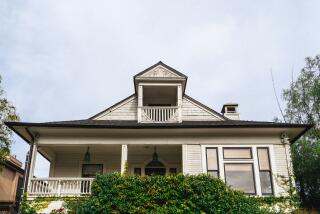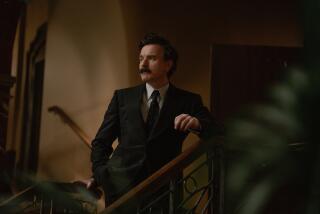Hospitality, Glasnot-Style : Until recently, tourists visiting the Soviet Union where limited to dreary, broken-down Intourist hotels. Now there are two new choices: restored grand hotels with Western comforts, and ‘B&Bs;’for those who want to meet real Russians.
MOSCOW — When a taxi drops you off at the Metropol or Savoy, a battalion of doormen will usher you from the gray street life of the Soviet capital into the luxurious world of turn-of-the-century Russia.
It used to be that when foreigners came to Moscow, their only choices for lodging were rooms provided by Intourist--the government-run tourism agency--in drab, Soviet-era high-rises or once-sumptuous-but-now-dilapidated hotels left over from Russia’s capitalist days. But now, two of Moscow’s most famous pre-revolutionary hotels offer a level of luxury even Communist Party bosses here would envy.
Both hotels have undergone dramatic reconstruction projects by non-Soviet companies. Restored to their old gilded grace but equipped with modern conveniences, they offer a glimpse into the indulgent lives of the upper crust in pre-Soviet Russia while providing 1990s comforts.
The best window on Moscow’s opulent past is the Metropol, a celebration of Russia’s architectural equivalent of ArtNouveau, both of which were popular in the late 19th and early 20th centuries.
As you walk into the Metropol, the marble floors, trim, stained-glass decorated elevator and classical music being played on a grand piano in the lobby create a mood of days long forgotten. Many of the guest rooms (especially the suites) are filled with an eclectic mixture of antique furniture that was in the hotel when it opened, just after the turn of the century, and has been newly restored at the famous Hermitage Museum in Leningrad.
Just a block from both Red Square and the Bolshoi Theater, the Metropol was a center of cultural life for Moscow’s rich and famous in the heady days of early 1900s.
Despite its rapidly declining glory during the decades of Soviet power, the Metropol remained the closest thing Moscow had to a landmark old grand hotel until it was closed for remodeling in 1985. It kept its place in the hearts of Muscovites, who recall spending afternoons sipping coffee and eating pastries in the cafe and popping champagne corks in the grand dining room to celebrate very special occasions.
Now it caters to an elite crowd of foreign business executives, wealthy travelers and VIPs. The new prices--all in U.S. dollars or other foreign currencies--exclude most Russians. Even a beer in the lobby bar costs $5--at the tourist exchange rate, equal to half a month’s salary for many Russians.
Once you settle into the Metropol, however, it quickly becomes apparent that Inter-Continental, the American chain that is running the hotel, has not been able to triumph over the inconveniences of Moscow. Since it opened its doors last March, it has gradually finished remodeling rooms (all 403 are scheduled to be open by September) and added amenities. But mini-bars are still empty (the hotel has not yet obtained the import license it needs to bring in foreign-made alcoholic and soft drinks in miniature bottles). There is also no room service, for the same reason.
The glaring turquoise, orange and cream carpet in some hallways and guest rooms is the unfortunate casualty of a boondoggle by a Soviet buyer in Finland before Inter-Continental took over. In the room where I stayed, the carpet clashed wildly with the paisley fabric on the furniture and gold and cream wallpaper.
The most pleasing part of my room, the bathroom--with a roomy tub, tasteful tile and large mirror--was hardly luxurious. But it was a world above the bathrooms in most Intourist hotels, which often feature cracked tiles, cockroaches, continually running toilets and showers without curtains.
The service at the restaurants at the revamped Metropol still suffers from old-style Soviet slowness. During a Sunday lunch at the European cafe, it took 30 minutes for the waiter to bring menus, then an hour more before some tasty, hot crab croquettes were served in tiny silver cups.
Breakfast at the Metropol is served in the main dining room, a glamorous hall with a huge painted glass dome and ornate frescoes on the walls. With a stained-glass window as a backdrop, a harpist plays as you help yourself to the buffet. Ordinary breakfast fare, such as scrambled eggs with cheese, pancakes and oatmeal, as well as fine pastries, were good. But the juices tasted like flavored sugar water.
Despite the inconveniences that management says will be smoothed out by time and training courses for the staff, the Metropol is well worthwhile for travelers willing to spend the money for a chance to live in history.
The hotel was sprayed with bullets during the 1917 Bolshevik Revolution that toppled the old order and brought an end to the lavish lifestyles of the capitalists and aristocrats for whom the Metropol was built. Bolshevik leader Vladimir I. Lenin made the hotel into a temporary home for the new government’s executive committee. Even the decision to execute the Czar and his family was made at the Metropol.
When the Soviet government moved into the Kremlin in the early 1920s, the Metropol became a hotel and apartment complex for Soviet officials and foreigners, but its wealthy splendor did not return until Soviet craftsmen launched an ambitious restoration project in the mid-1980s.
“Beautiful frescoes, gold and silver leaf and lovely stained-glass windows had all been painted over with white paint,” said Ludmila V. Sokolovskaya, the architect who headed the restoration. “We did everything we could to restore it to the way it looked before the revolution.”
Craftsmen peeled layers of paint to discover frescoes that were painted nine decades ago and re-created the original designs. Architects searched archives to find designs of original tiles, stained-glass windows, furniture, lamps and draperies.
Many of the suites were restored to their original appearance, and each is different. Many have beautiful parquet floors covered with hand-woven carpets from Soviet Central Asia. Others have Art Nouveau-style furniture and some are even decorated with gold leaf and marble columns.
The building’s unique facade helped win the hotel the title of “historic monument.” The top layer features elaborate tile mosaics that depict popular folk or mythic tales, the most famous of which is a princess greeting her prince, who is at death’s door after two years on the high seas searching for her.
Just a few blocks away, the Savoy was the first pre-revolutionary hotel to be remodeled when it opened its doors in August, 1989, to immediate acclaim. Business executives visiting Moscow vied to stay in its 68 rooms, despite prices that are now as high as $735 for a suite. Booking was especially difficult because, as a joint venture between Soviet and Finnish partners, reservations are almost entirely restricted to Finnair passengers.
Much cozier than the Metropol, but still high on pre-revolutionary grandeur--with sculptures of life-size goddesses in the lobby and gold- and silver-plated trim in the restaurant and bar--the Savoy provides a chance to live in a historic Moscow hotel that already functions according to Western standards.
At the Savoy, guests can tune in a movie channel or CNN to catch the latest news (TVs in Intourist hotels have only Soviet channels with often blurry pictures). The chance to watch fresh news cannot be overrated in a place where as little as three years ago, visitors were totally cut off from current Western news reports. At the Metropol, even the most glamorous suites are only equipped with basic Soviet TV sets, although management promises that foreign-made TVs and CNN are on order.
The room where I stayed in the Savoy was cramped--with just a sliver of space on each side of a soft, comfortable double bed--but was equipped with modern conveniences that the Metropol lacked, such as a hair dryer and home valet to fight wrinkles without having to send clothes out for pressing. There were even delicious good-night mints on the pillows.
Thick dark curtains disguised the not-so-glamorous view of the empty shelves at a store across the street.
Another advantage of the Savoy is a working business center to provide guests with secretarial service and international telephones and faxes (you can’t make long-distance calls from rooms). Although the Metropol boasts that it will open a far superior business center in the next few months, currently the only way to make an international call is by a direct-dial pay telephone in the lobby (although this is still far superior to Intourist hotels, where you have to place orders for long-distance calls long in advance).
But the thing that promises to continue to set the Savoy apart from the Metropol is its first-class restaurant. The solid silverware, crystal glasses and doting service create an atmosphere unlike any other dining experience in Moscow.
While you’re waiting for your food, glance up at the gilded and pink ceiling, inlaid with mirrors, and marvel at the large marble fountain with ornate ironwork and artificial flowers. If you look out the windows on to the street, however, you might see a very different sight: hungry Muscovites lined up to buy tiny, bland meat dumplings called pilmeni .
Unlike the dawdling waiters at the Metropol, the staff at the Savoy restaurant is superbly trained. Best of all, the food is absolutely sinful. While most of the food on the Metropol menu was bought locally, the Savoy serves almost exclusively dishes made from imported ingredients. The mixed salad--with greens, sweet peppers and exotic fruit--is the best in Moscow. The salmon with whiskey sauce almost melted in my mouth. Caviar on buckwheat blini (pancakes), snow grouse, medallion of wild boar and smoked tongue of reindeer are some of the delectable European and Russian dishes.
But the prices are astronomical (about $85 per person for dinner), so you might want to have a less costly bite in the bar. The service here--in contrast to the main dining room’s--is slow as the couple of waiters hustle up and down the stairs of the two-story rococo bar. The menu is quite small, and the entrees taste a lot like microwaved dinners, but the salmon sandwich appetizer makes a tasty light meal.
If the food does not satisfy your capitalist indulgence cravings, the Savoy has Moscow’s first casino--which now abound in the city. Guests are welcome to sip drinks and bet their hard-earned foreign currency at the blackjack table.
GUIDEBOOK
Moscow Luxury Hotels
Hotel Metropol: 1 Prospekt Marxa, 103012, Moscow, Soviet Union. Reservations through Inter-Continental Hotels Group, telephone (800) 327-0200 or dial direct from the United States: 011-7-095-927-6096; fax 011-7-095-975-2355. Single or double room rates: $300-$360; Metropol mini-suite: $420; executive and deluxe suites: $710-$810; presidential suite: $1,210.
Hotel Savoy: 3 Ulitsa Rozhdestvenka, 103012, Moscow, Soviet Union. Room and airline reservations through Finnair, telephone (800) 950-5000. There are a small number of rooms available for tourists not traveling on Finnair, but they are usually booked and difficult to reserve. From the United States, telephone 011-7-095-929-8500; fax 011-7-095-230-2186. Rates: single $245, double $300; mini-suite: $410; deluxe suite: $710.
Both hotels provide car pickup from the airport for a fee.
More to Read
Sign up for The Wild
We’ll help you find the best places to hike, bike and run, as well as the perfect silent spots for meditation and yoga.
You may occasionally receive promotional content from the Los Angeles Times.






